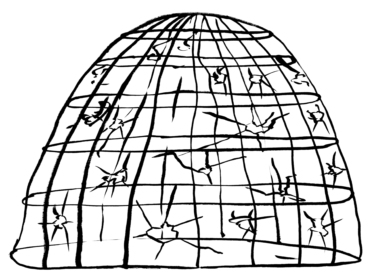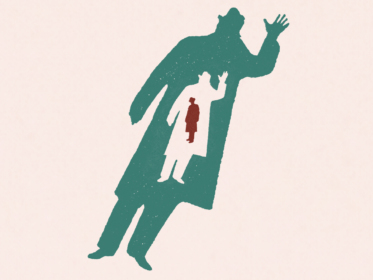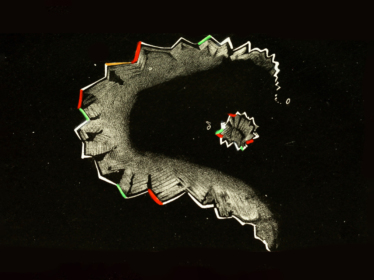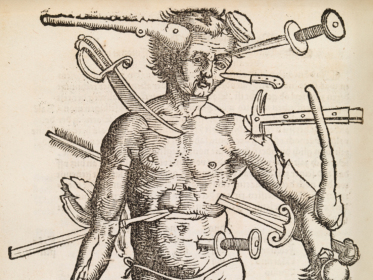No Wall, Only Fire

The Brandmauer (firewall) is a German artifice that used to mean a simple thing: post-fascist politics must be different from fascist politics. It was institutionalized in Germany’s constitution, in its commitment to international law, to universal asylum, to the Geneva convention. These days, the Brandmauer has been reduced to an agreement not to make parliamentary decisions with votes from the far-right Alternative for Germany (AfD). To much outrage, this so-called taboo was broken on January 29, 2025 in the German parliament. I argue that the real scandal lies elsewhere: in the reduction of a post-fascist consensus to political games between parties.
This happened on that day for a reason: There is a larger machine at work producing revisionist magic that is helping Germans to collectively move past their guilt and leave their much-lauded memory culture behind. This machine can be traced through the three-part movement of that day, a collective choreography from memory to deportation to authoritarianism.
Movement 1: Noon
Throughout the day, politicians were dressed in black (with the exception of a flaming red Sahra Wagenknecht), because the parliamentary session opened at noon with a commemoration of the Red Army’s liberation of Auschwitz-Birkenau 80 years ago. “The sun shines there as well,” said Bundestag president Bärbel Bas in her opening, and German President Frank Walter Steinmeier invoked Hitler’s invasion of Ukraine and how it was repeated in Russia’s current war.
The Bundestag then listened to Roman Schwarzmann, a Holocaust survivor from Odessa, who spoke of hunger and flight, of persecution and forced migration, of surviving genocide, and how Putin is doing to the old Ukrainian what Hitler did to the young Jew. The speech underscored Steinmeier’s earlier plea against the “routine of memory” — to not stifle the memory of the Shoah in empty rituals and phrases, but to keep remembrance and compassion alive by meeting the challenges of the present: “We know better. Let’s do it better,” Steinmeier said. With the current enemy of Jews identified primarily as Russian, the solemnly dressed parliament broke for lunch.
Movement 2: 2 p.m.
The politicians reassembled in the Bundestag to discuss the Christian Democratic Party (CDU)’s motion for a resolution shorthanded as the Zustrombegrenzungsgesetz (Influx Limitation Act). The monstrously worded bill would have gutted the already-flayed notion of universal asylum in Germany, had the law itself not failed to pass two days later: closed and heavily policed German borders, the termination of family reunification, extended deportation powers for state police, and refusal of entry for processing in third party states were among its harsh demands. Its wording was unambiguously fluvial: an immense “river” (Strom) of migrants was flowing into Germany, its volume had to be limited. Friedrich Merz — the CDU’s increasingly firebrand candidate for chancellorship in the current election campaign who spearheaded the motion — left no doubt about the urgency of such a limit. Merz legitimized the cap on what he termed “illegal migration” by invoking the recent murder of a two-year-old German-Moroccan boy at the hands of an Afghan asylum seeker in Aschaffenburg. Merz insisted that without a rigid deportation regime “our compassion and sympathy … degenerate more and more into a political ritual.”
This echo of Steinmeier’s call against the ritualization of memory was repeated many times throughout the heated debate. In keeping with decorum, almost every speaker drew connections between remembering the Holocaust and deploring the murder of a child, inevitably to argue for what the bill called aufenthaltsbeendende Maßnahmen (presence-ending measures) for “illegal” migrants. Speaker after speaker intoned rage at migrant crime and claimed empathy for its victims, gliding effortlessly from Holocaust memory to the necessity of deportation bills in order to “do better,” as Steinmeier had demanded. Lars Klingbeil (SPD) was stirred in his soul and moved from past guilt to present outrage: “Today at noon, we remembered the terrible crimes of the Second World War and the Nazi regime and commemorated the victims of the Holocaust. This afternoon we heard the chancellor’s government statement on the brutal and cowardly murder of two-year-old Yannis in Aschaffenburg — a murder that shocked us all.”
Alexander Dobrinth (CSU) was appalled by the routines and rituals, referring to the current administration’s alleged downplaying of the wave of “criminal” migrants. He forcefully addressed chancellor Scholz: “I’m fed up. … It’s always the same ritual […] after the most serious crimes: first rhetoric of affectedness, then a warning about reactions, then a return to business as usual.” The most serious crimes ever committed by Germans, commemorated only two hours earlier by a surviving witness, were now found to be connected with migrants, with asylum seekers, with people “who shouldn’t have been here,” as Merz put it.
Calling for an acknowledgment of the “immigrated antisemitism on German streets,” Christian Lindner (FDP) was the first to make the connection explicit that all other speakers tacitly invoked: If the victims of Germany’s past must be avenged by removing “migrant criminals” from the German present, then antisemitism finally can, and must, be deported from Germany. Former AfD (and now-independent) far-right parliamentarian Matthias Helferich extolled the man who had died intervening in the Aschaffenburg knife attack, and did so in the vocabulary of a Landser-novel: “punctured by countless wounds, he collapsed and with his last breath reached for the stroller, where his own child witnessed the father’s death. … Now is the time for heroes, time for responsibility, … the time for righteous anger.”
Such was the transformation between the first two movements, from “we know better” to “let’s do better,” as Steinmeier had said: In order to properly remember the mass murder and mass flight of Jews at the hands of Germans, the politicians convinced each other to further deport, to deny entry, to end the presence of those “irregularly” seeking asylum. From Jewish victims to German victims, from German murder to the murder of Germans at the hands of illegal aliens. “What more needs to happen in Germany? How many more people have to be killed?” asked Friedrich Merz, likely the country’s next chancellor, as he argued for a wholesale xenophobic deportation bill, as if a murderous regime had invaded the country.
AfD hecklers congratulated Merz, which was their only job on this day: to applaud, stress, and sharpen what all other parties had to say. With joint support from the AfD, CDU/CSU and FDP, the motion was scheduled for a deciding vote the following Friday, where it failed to reach a majority. The so-called scandal of the AfD and CDU joining votes, however, was a mere lubricant for the greater consensus — that Holocaust memory must energize the deportation regime, that antisemitism is a foreign ideology, and that Germans are its heroic victims in need of righteous self-defense.
The parliamentary session felt akin to a choreographed dance: To escape memory’s routinization, Germans must vacate their guilt, seal it up in foreign bodies, and deport it from German territory in order to save citizen’s lives from mass murder, in an outspoken disregard of European law and international convention.
Movement 3: 9 p.m.
The conjoining of past Nazi crime and present migrant crime were resolved in the third movement of the parliament’s day: In the evening, a small group of politicians remained in the Reichstag to debate yet another paper, a cross-party resolution to “oppose antisemitism and hostility to Israel in schools and universities and to secure free discourse.” Any tensions produced in the earlier transmutations of memory into xenophobia were smoothed out by a joint declaration that any and all efforts to strengthen “Fort Germany” were ultimately based in the collective fight against “antisemitism,” for the protection of abstracted “Jewish life” and the “openness of discourse.” October 7 featured prominently in the resolution’s text and all speeches, used repeatedly to target universities specifically as sources of a new wave of antisemitism.
Apart from (again) mandating the IHRA-definition and increased securitization of the academy, the resolution leaned heavily into the conflation of Jews and pro-Israel Germans as equal victims of antisemitism: “Non-Jewish students, teachers and employees who express their solidarity with the State of Israel and Jews in Germany … are also being threatened,” read the resolution, locating the imminent danger in Palestinian, Muslim, and leftist organizations and actors.
Mathias Stein (SPD) stressed this — Germans falling victim to inherent leftist and Muslim antisemitism — in his speech, demanding empathy and protection for his own person: “After October 7, … Jews in Germany are once again afraid of right-wing, left-wing extremist and also Islamist attacks. I had to experience that myself. An attack was carried out on me in the form that I, as vice president of the German-Israeli-Society, was described as a warmonger.” Michael Kaufmann (AfD) invoked the larger movement of the day at length and warned his colleagues not to diminish the current antisemitic threat in a false sense of historically induced shame:
“The threat to Jews in Germany and to the state of Israel today comes primarily from left-wing extremism and Muslim antisemitism. … Your resolution … bashfully conceals the true dimension of Jew-hatred among Muslims. … The fact that we are dealing with uncontrolled immigration has brought tens of thousands of ardent Jew-haters into the country. So make sure that these people leave Germany again!”
With the arc from Holocaust memory to the protection of Jews and Germans (and Israel) thus completed, the deportation of Muslims and other groups lumped together as “ardent Jew-haters” had become plausible as a measure against antisemitism and for the protection of free speech on campus. Kaufmann was convincing, and no other voice intervened. Monika Grütters (CDU) brought the authoritarian point home and singled out recent incidents at the Alice Salomon Hochschule as troubling proof that increased police presence and securitization on campus was necessary, for the university’s administrators had defended pro-Palestine “occupants with their calls for the destruction of Israel, but saw the police, of all people, as a threat.” She recommended additional antisemitism commissioners for all universities, as well as “increased cooperation between administrators and the secret services.” Thomas Jarzombek (CDU) delivered the last speech, effortlessly reiterating the day’s movement — from knowing better to doing better, from Holocaust memory to xenophobia to repression of protest, all in the name of “Never Again:” “Never Again! is not a spectator sport, ladies and gentlemen, not in politics and not in the university. We have much to do.”
Epilogue: Farewell, Memory Culture
The power of structures is to move through individuals without them necessarily being conscious of it. The power of structural transformations is to move people in a half-conscious choreography like a secret dance. The so-called Germans are famously capable of such dances. There are of course many beginnings to such a large revisionist movement, and I want to name one: On October 17, 2023, Benjamin Netanyahu used a joint press conference with Olaf Scholz to proclaim “Hamas are the new Nazis.” Scholz, like a spectator, said nothing. His silence acknowledged the proposed task and the narrative arc: There are new Nazis, they are not Germans this time but Palestinians, and Germany can redeem itself in the fight against them, against the original antisemitic threat. Netenyahu offered a container for German guilt, and promised Germany’s redemption if the container logic was accepted.
Germany’s staunch support of Netanyahu’s devastating war, the complete destruction of Gaza and large-scale resettling of the West Bank, the mass murder and displacement of the Palestinian population — that is the movement of acceptance. The authoritarian repression of any protest, criticism or dialogue is part of this bargain, as Germany can funnel the national grappling with its fascist past into a fight against new targets: refugees, leftists, Muslims, representatives of the international order. Only last week, political pressure by Berlin’s ruling CDU-SPD coalition caused the cancellation of an event with Francesca Albanese, UN special rapporteur on the Occupied Palestinian territories, and Eyal Weizman, director of Forensic Architecture, at Free University Berlin, after concerted warnings of likely antisemitic messaging. Without evidence or any mention of Weizman’s Jewish-Israeli identity, mayor Kai Wegner attacked the UN representative in BILD and the university folded without quarrel. No criticism is allowed, not of genocide, not of deportation logistics, not of authoritarian turns in Germany or elsewhere — neither by United Nations representatives nor by Jewish academics. All in the name of “never again” after October 7.
This is the movement, the machine working through the German political landscape and collective psyche. The postwar German psyche was built in two different ways with a wall running between them, and it has been trying to fuse into one since reunification 35 years ago. It now has finally achieved this fusion via Gaza and Aschaffenburg, productive accelerants for the majority’s anti-Arab racism and desire for homogeneity and redemption as reunited Germans. They are neither antisemites nor Nazis anymore, but victims and heroes. This collective vacating of the Nazi past via deportation regimes also means that the AfD are no longer its most important Wiedergänger (returning ghosts), but the drivers of Germany’s new post-memory consensus. The tired Brandmauer discussion is, in other words, an item of nostalgia, and current demonstrations against the AfD/CDU collaboration address a marginal problem, a conflict of the past: The German consensus is already ethnonationalist and post-European. Its natural expression is black and blue, the CDU and AfD colors, respectively. You can see it on the projected voting maps: black west, blue east. The racist and authoritarian drift has come into its own and the German state is ready to claim its place in the nationalist international.
This article was amended on 28th February 2025. An earlier version incorrectly said that only Jewish victims were mentioned until 10pm. In Bärbel Bas’ speech earlier that day, all victims of the Holocaust were mentioned.



